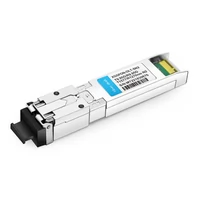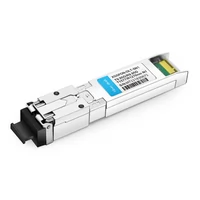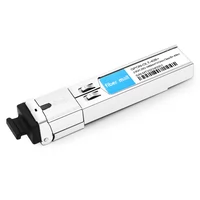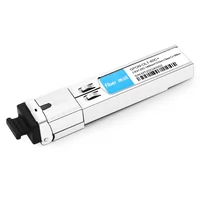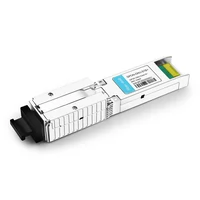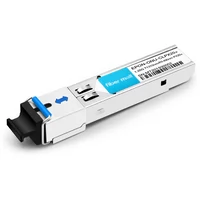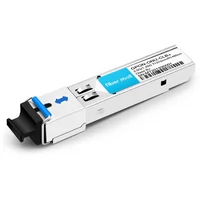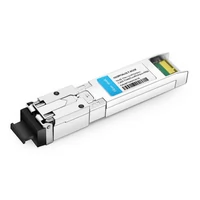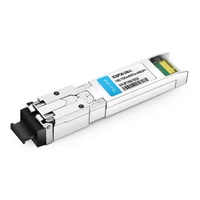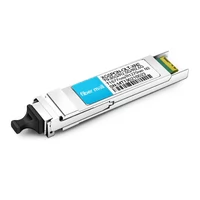In our daily life, we get news, use social software and shop online through access networks, which are all devices between the backbone network and the user terminal. With the progress of technology and the increasing amount of IP services in the network, optical access network technology has gradually become the key to the development of access networks.
FTTC (Fiber To The Curb), FTTB (Fiber To The Building), and FTTH (Fiber To The Home) are all types of optical access network applications that are widely used today.
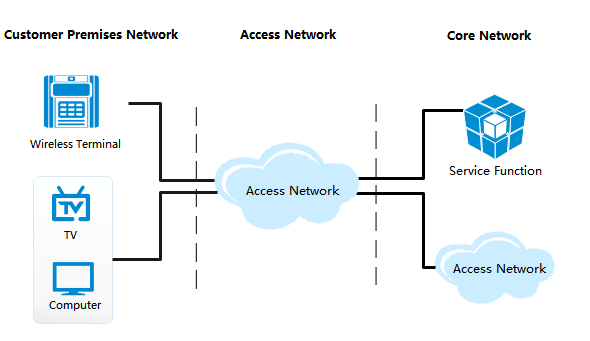
Let’s get to know the three “O’s” of optical access network: OLT, ODN, and ONU.
ONU (Optical Network Unit) is a client device in optical network; ONU provides data, IPTV (Internet Protocol Television), voice (Integrated Access Device), and other services.
ODN (Optical Distribution Network) is an optical cable network based on PON equipment; ODN provides optical transmission channels for OLT and ONU.
OLT (Optical Line Terminal) refers to the terminal equipment used to connect fiber optic trunk lines; network element management, security management, configuration management, and bandwidth allocation can be realized on the OLT.
Table of Contents
ToggleWhat is the Relationship Between the Three O’s?
The relationship between OLT, ONU, and ODN in the access network is shown in the figure below.
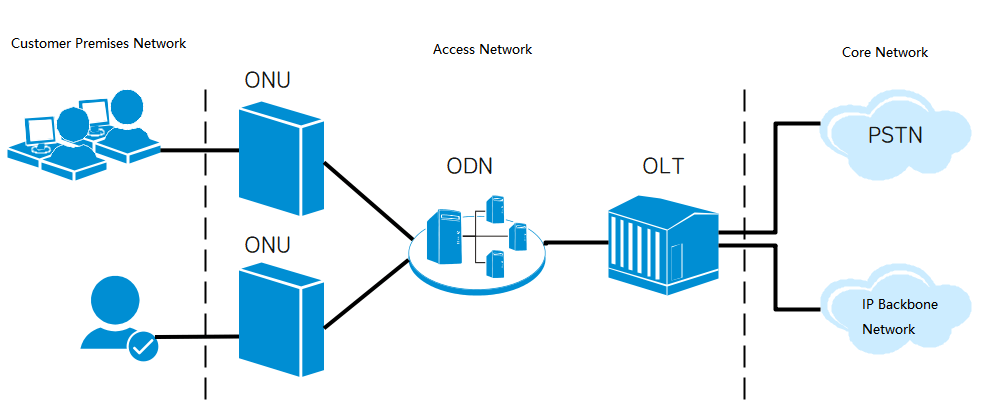
The OLT will collect the information passed by the core network and process it to the ODN, while the information passed by the ONU through the ODN will be collected and processed to the core network.
ODN provides optical transmission channels for OLT and ONU.
Each ONU analyzes the signals transmitted from the ODN and then takes out the part belonging to this ONU; the ONU also arranges the user information sent to the ODN at the same time.
ONU
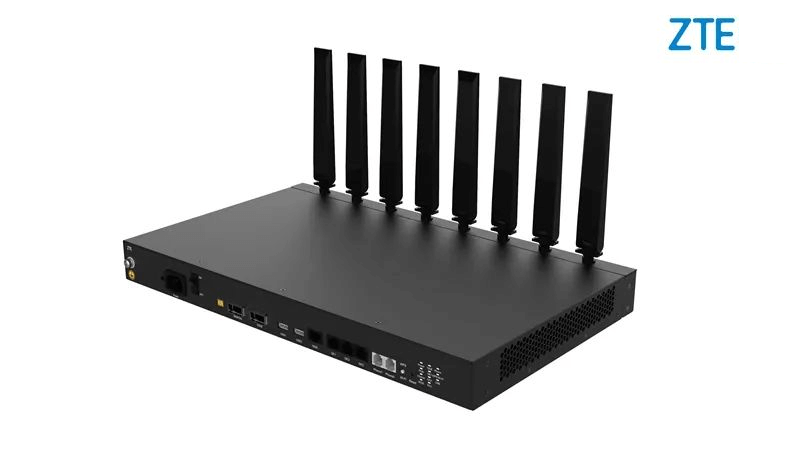
Concept
ONU (Optical Network Unit) is a client-side device in the optical network, placed at the client side and used in conjunction with OLT.
ONU provides services such as data, IPTV (Internet Protocol Television), and voice (Integrated Access Device), and realizes Ethernet Layer 2 and Layer 3 functions.
Functions
- Select to receive the data sent by OLT.
- Respond to the commands sent by OLT and adjust accordingly.
- Cache the user’s Ethernet data and send the user’s Ethernet data to the OLT.
- User and service multiplexing function: assembling information from each user; connecting individual service interfaces.
- Transmission multiplexing function: analyze the signals transmitted from the ODN and take out the part belonging to the ONU and arrange the information to be sent to the ODN in a reasonable way.
- ODN interface function: provide a series of optical physical interfaces including optical/electrical and electrical/optical conversion.
Based on the three basic types of applications for optical access networks, ONUs can be classified into three types:
Plug-in ONU, Box type ONU, and In-home ONU.
Plug-in ONU: mainly used for FTTC (fiber to the curb), ONU is set at the DP point (at the entry hole on the curb or at the splitter box on the pole) or at the FP point (at the switch box), at which time the ONU is connected to each user through twisted-pairs.
BOX ONU: mainly used for FTTB (fiber to the building), ONU set up in the building, there are multiple pairs of twisted-pair cable to distribute services to each user.
In-home ONU: mainly used for FTTH (fiber to the home), ONU set in the user’s home, to provide users with broadband interactive services, the local switch until the user’s home line all use optical fiber.
ODN
Concept
ODN (Optical Distribution Network) is an optical cable network based on PON equipment.
ODN mostly adopts P2MP (point 2 multiple point) topology, as shown in the figure below. There are more nodes in the ODN network and the network management is complicated, so the construction cost of the ODN network is relatively high, up to 50%~70% of the overall investment.
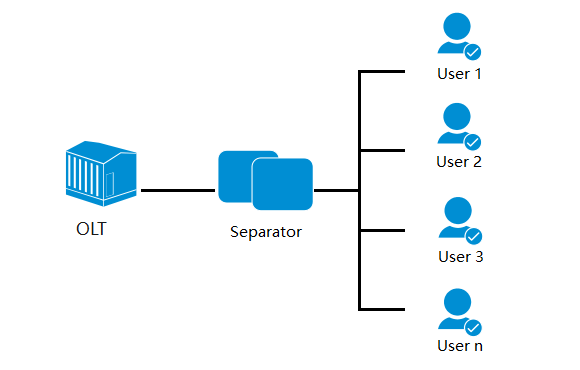
Functions
To provide optical transmission channels for OLT and ONU.
ODN includes five parts: feeder segments, optical distribution points, wiring segments, optical access points, and in-home segments, as shown in the following figure.

Feeder section: The feeder section is from the ODF (optical distribution frame) of the local office to the fiber optic cable distribution point. The feeder section is used as the backbone cable to achieve long-distance coverage.
Wiring section: From the distribution point to the user access point is the wiring section. The wiring section distributes fiber to the user area along the way.
In-home section: the user access point to the terminal is the in-home section. The in-home segment is used to realize fiber to the home.
OLT
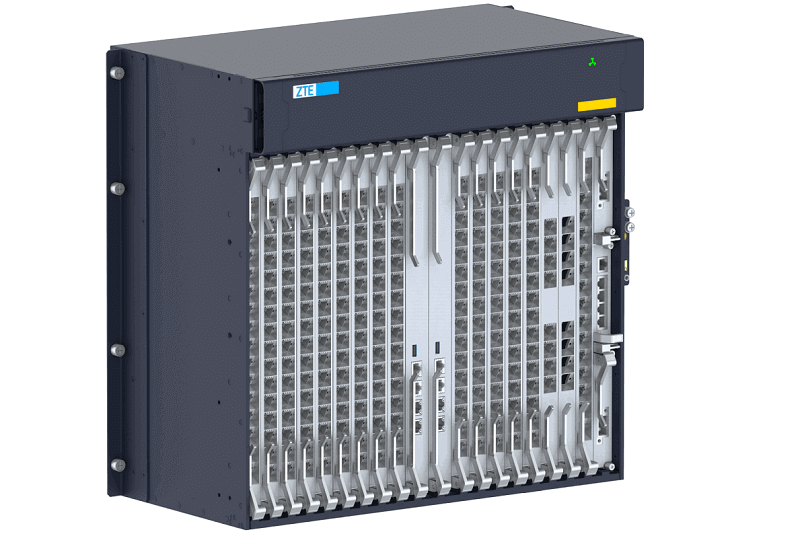
Concept
OLT (Optical Line Terminal) refers to the terminal equipment used to connect fiber optic trunk lines.
OLT is equivalent to a switch or router in a traditional communication network. The OLT is also capable of bandwidth allocation for different users’ QoS/SLA requirements.
Functions
Uplink the upper layer network to complete the uplink access of PON (Passive Optical Network); converge the signals from various services and transmit them to end users according to a certain format.
Through the ODN network, it connects the user terminal equipment ONU; sends the signals from users into various service networks according to the service types; and realizes the functions of control, management, and ranging for ONU.
OLT can be divided into three parts: core part, service part, and public part.
Core part: including convergence and distribution, service processing, and ODN adaptation functions.
Service part: provides service interface functions, including interface adaptation, interface protection, etc., as well as signaling processing and media transmission standard conversion functions for specific services when needed.
Public part: including power supply and OAM functions.
Related Products:
-
 FiberMall XGSPON-OLT-SN2 XGSPON OLT SFP+ TX-9.95G/RX-9.95G, 2.488G Tx-1577nm/Rx-1270nm SN2 SC UPC DDM Optical Transceivers
$315.00
FiberMall XGSPON-OLT-SN2 XGSPON OLT SFP+ TX-9.95G/RX-9.95G, 2.488G Tx-1577nm/Rx-1270nm SN2 SC UPC DDM Optical Transceivers
$315.00
-
 FiberMall XGSPON-OLT-SN1 XGSPON OLT SFP+ TX-9.95G/RX-9.95G, 2.488G Tx-1577nm/Rx-1270nm SN1 SC UPC DDM Optical Transceivers
$300.00
FiberMall XGSPON-OLT-SN1 XGSPON OLT SFP+ TX-9.95G/RX-9.95G, 2.488G Tx-1577nm/Rx-1270nm SN1 SC UPC DDM Optical Transceivers
$300.00
-
 GPON-OLT-40B+ GPON OLT SFP TX-2.5G/RX-1.25G TX-1490nm/RX-1310nm Class B+ 40km SC SMF DDM Transceiver Modules
$30.00
GPON-OLT-40B+ GPON OLT SFP TX-2.5G/RX-1.25G TX-1490nm/RX-1310nm Class B+ 40km SC SMF DDM Transceiver Modules
$30.00
-
 GPON-OLT-60C+ GPON OLT SFP TX-2.5G/RX-1.25G TX-1490nm/RX-1310nm Class C+ 60km SC SMF DDM Transceiver Modules
$38.00
GPON-OLT-60C+ GPON OLT SFP TX-2.5G/RX-1.25G TX-1490nm/RX-1310nm Class C+ 60km SC SMF DDM Transceiver Modules
$38.00
-
 GPON-ONU-STB+ GPON ONU Stick SFP (with MAC function)TX-1.25G/RX-2.5G TX-1310nm/RX-1490nm Class B+ 20km SC/UPC SMF DDM Transceiver Modules
$45.00
GPON-ONU-STB+ GPON ONU Stick SFP (with MAC function)TX-1.25G/RX-2.5G TX-1310nm/RX-1490nm Class B+ 20km SC/UPC SMF DDM Transceiver Modules
$45.00
-
 EPON-ONU-CLPX20+ EPON ONU SFP TX-1.25G/RX-1.25G TX-1310nm/RX-1490nm PX20+ 20km SC\UPC SMF DDM Transceiver Modules (Not EPON ONU STICK,NO MAC function)
$12.00
EPON-ONU-CLPX20+ EPON ONU SFP TX-1.25G/RX-1.25G TX-1310nm/RX-1490nm PX20+ 20km SC\UPC SMF DDM Transceiver Modules (Not EPON ONU STICK,NO MAC function)
$12.00
-
 GPON-ONU-CLB+ GPON ONU SFP TX-1.25G/RX-2.5G TX-1310nm/RX-1490nm Class B+ 20km SC/UPC SMF DDM Transceiver Modules (Not GPON ONU STICK,NO MAC function)
$15.00
GPON-ONU-CLB+ GPON ONU SFP TX-1.25G/RX-2.5G TX-1310nm/RX-1490nm Class B+ 20km SC/UPC SMF DDM Transceiver Modules (Not GPON ONU STICK,NO MAC function)
$15.00
-
 10GEPON-OLT-SGCE Symmetric 10GEPON OLT and 1.25G EPON OLT in an SFP+ Housing TX 1577nm (10.3G)/1490nm (1.25G) RX 1270nm (10.3G)/1310nm (1.25G) PR30 SC DDM Optical Transceivers
$225.00
10GEPON-OLT-SGCE Symmetric 10GEPON OLT and 1.25G EPON OLT in an SFP+ Housing TX 1577nm (10.3G)/1490nm (1.25G) RX 1270nm (10.3G)/1310nm (1.25G) PR30 SC DDM Optical Transceivers
$225.00
-
 XGSPON-ONU-C XGSPON ONU SFP+ TX-9.95G/RX-9.95G TX-1270nm/RX-1577nm N1/N2 SC DDM 0°C~70°C Optical Transceivers
$75.00
XGSPON-ONU-C XGSPON ONU SFP+ TX-9.95G/RX-9.95G TX-1270nm/RX-1577nm N1/N2 SC DDM 0°C~70°C Optical Transceivers
$75.00
-
 XGSPON-OLT-XN2 XGSPON OLT XFP TX-9.95G/RX-2.5G/RX-2.5G TX-1577nm/RX-1270nm N2 SC DDM Optical Transceivers
$1095.00
XGSPON-OLT-XN2 XGSPON OLT XFP TX-9.95G/RX-2.5G/RX-2.5G TX-1577nm/RX-1270nm N2 SC DDM Optical Transceivers
$1095.00

